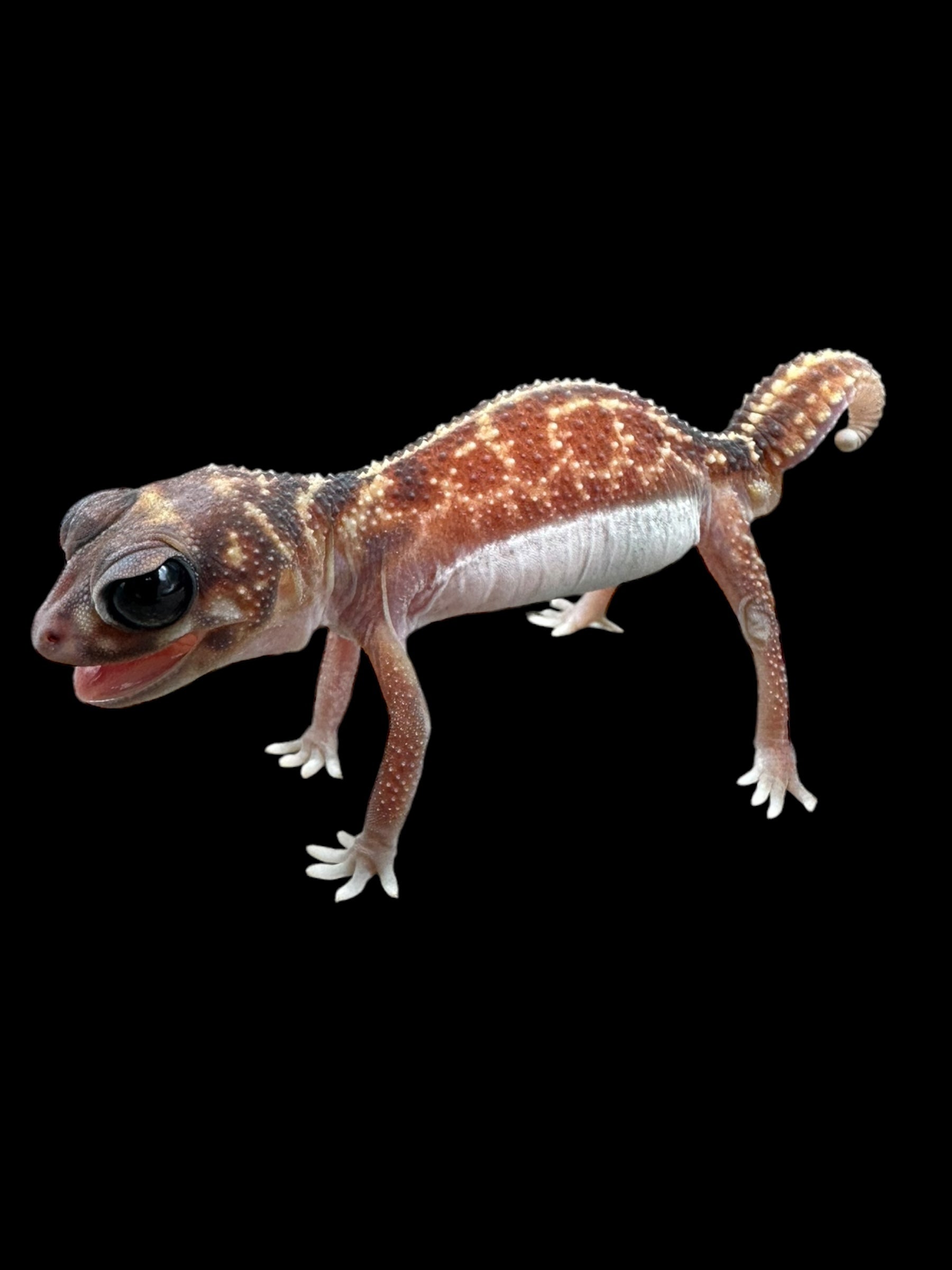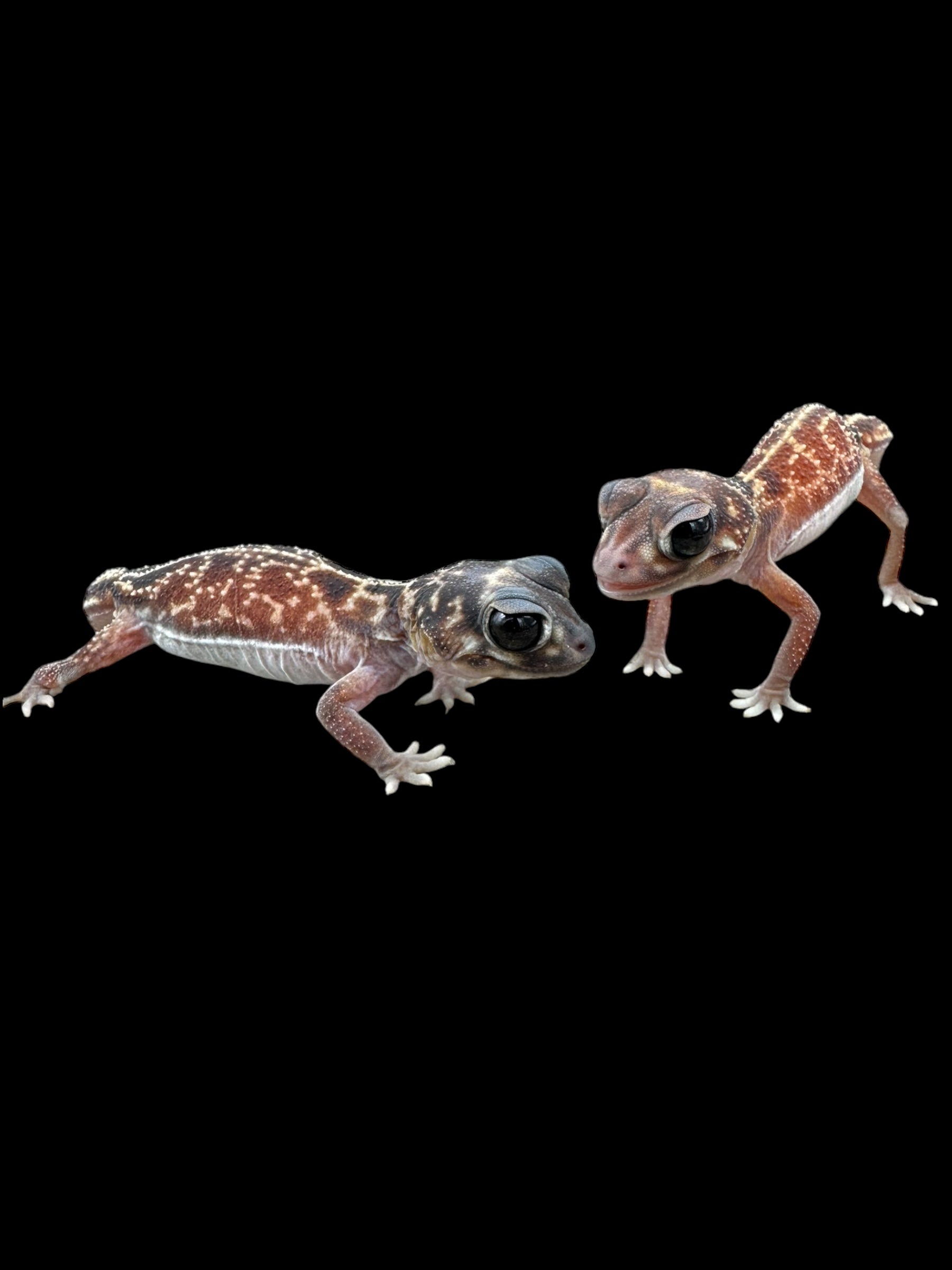Photo Disclaimer
Description
Midline Knob-Tail Gecko
Scientific Name: Nephrurus vertebralis
Common Name: Midline Knob-Tail Gecko
Species Overview
Size: Adult Midline Knob-Tail Geckos typically reach 4–5 inches (10–13 cm) in total length, including the tail. They are compact, ground-dwelling geckos with short limbs, a thick body, and a small, rounded tail ending in the characteristic “knob” that defines the genus.
Appearance: Nephrurus vertebralis exhibits a sandy to reddish-brown base colour with lighter spotting or speckling across the back and sides, blending perfectly with the desert substrate. A distinct pale or dark midline stripe runs along the spine from head to tail, giving the species its name. The head is broad with large, lidless eyes of bronze or grey hue, and the body texture is granular with small raised tubercles. The short, knobbed tail is used for communication and fat storage, often twitching or curling when the gecko feels threatened.
Distribution: Endemic to arid regions of Western Australia and parts of South Australia.
Habitat: In the wild, Midline Knob-Tail Geckos inhabit sandy or loamy desert plains, dunes, and scrublands, sheltering in shallow burrows or beneath vegetation during the day. They are primarily nocturnal, emerging at night to hunt small invertebrates. In captivity, they thrive in semi-arid, ground-based enclosures with soft substrate for burrowing and moderate nighttime humidity.
Behaviour: These geckos are nocturnal and terrestrial. They are inquisitive but can be defensive if startled, producing chirps or squeaks and using their tails to distract predators. Once accustomed to their environment, they are confident feeders and display fascinating hunting behaviour.
Captive Care
Enclosure: Provide a terrestrial enclosure measuring at least 18 inches × 18 inches × 12 inches (45 × 45 × 30 cm) for one adult. Use a sandy soil mix or fine desert substrate deep enough (2–3 inches) to allow digging. Include low rock hides, driftwood, and cork flats for security. A naturalistic semi-arid setup closely mimics their wild habitat and encourages natural behaviour.
Temperature & Humidity: Maintain a daytime temperature gradient of 82–90°F (28–32°C) with a localized basking area reaching 92°F (33°C). Nighttime temperatures can drop to 68–74°F (20–23°C). Keep humidity low during the day (30–40%) and slightly higher at night (50–60%) with light misting to replicate desert dew. Ensure good ventilation to prevent excess moisture.
Lighting: Although nocturnal, Midline Knob-Tail Geckos benefit from low-level UVB (2–5%) to support calcium metabolism and natural circadian rhythms. Maintain a 12-hour light cycle with soft ambient illumination.
Diet: Feed gut-loaded insects such as crickets, roaches, and mealworms. Offer food 3–4 times per week, dusting prey with calcium and multivitamin supplements regularly. Avoid overfeeding, as obesity can develop in captive knob-tails due to their slow metabolism and efficient fat storage.
Behaviour in Captivity: Midline Knob-Tail Geckos are hardy and easy to observe once acclimated. They are active hunters at night, displaying slow, deliberate movements and tail-twitching communication. With stable warmth and secure hides, they thrive and can live 10–15 years in captivity.
Special Considerations: Avoid overly moist substrates or poor ventilation, as these geckos are prone to skin infections in damp environments. Always provide a shallow water dish and a small humid hide to assist with shedding, but maintain overall dry conditions.
Taxonomy Note
The Midline Knob-Tail Gecko (Nephrurus vertebralis) belongs to the family Carphodactylidae and is one of several Australian knob-tail species. It can be distinguished from relatives such as Nephrurus levis and Nephrurus wheeleri by its continuous pale dorsal stripe and slightly longer, slimmer tail. Members of this genus are unique among geckos for their rounded “knob” tail tips and vocal defensive displays.
Genetics Note
There are currently no recognized morphs or selectively bred variants of Nephrurus vertebralis. Natural variation occurs in the intensity of the dorsal stripe and the richness of the body colour, often influenced by locality and environmental adaptation rather than selective breeding.


